Scaffolding Rental Canyon Lake
Find Scaffolding Rental Services in Canyon Lake
Receive multiple Temporary Scaffolding quotes for your project today! Compare profiles, reviews, accreditations, portfolio, etc... and choose the best deal.
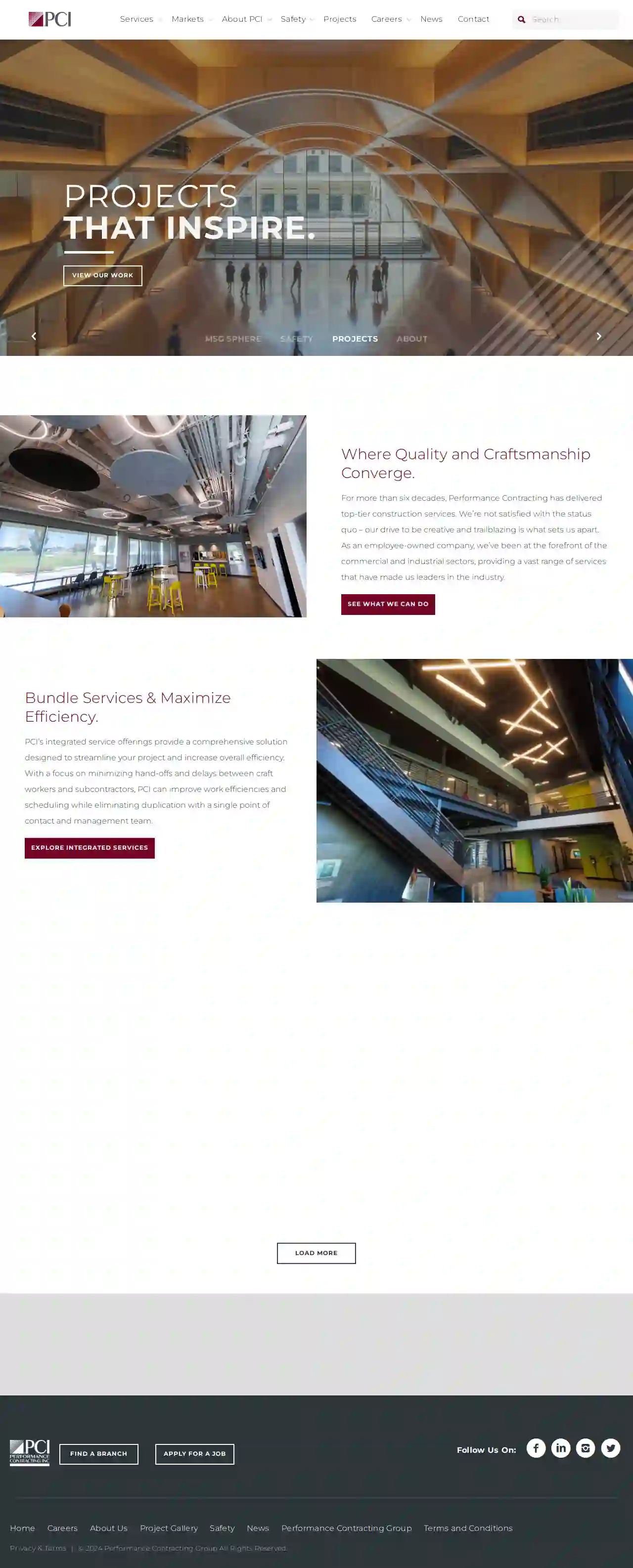
PCI Scaffold & Insulation
3.65 reviews123 Main St, Springfield, IL, 12345, USPerformance Contracting, Inc. is a leading specialty contractor in the United States, offering a wide range of services and solutions tailored to the specific needs of diverse market sectors. With over 60 years of industry experience, PCI delivers top-tier construction services, focusing on minimizing hand-offs and delays between craft workers and subcontractors to improve work efficiencies and scheduling. PCI's integrated service offerings provide a comprehensive solution designed to streamline projects and increase overall efficiency.
- Services
- Why Us?
- Accreditations
- Our Team
- Testimonials
- Gallery
Get Quote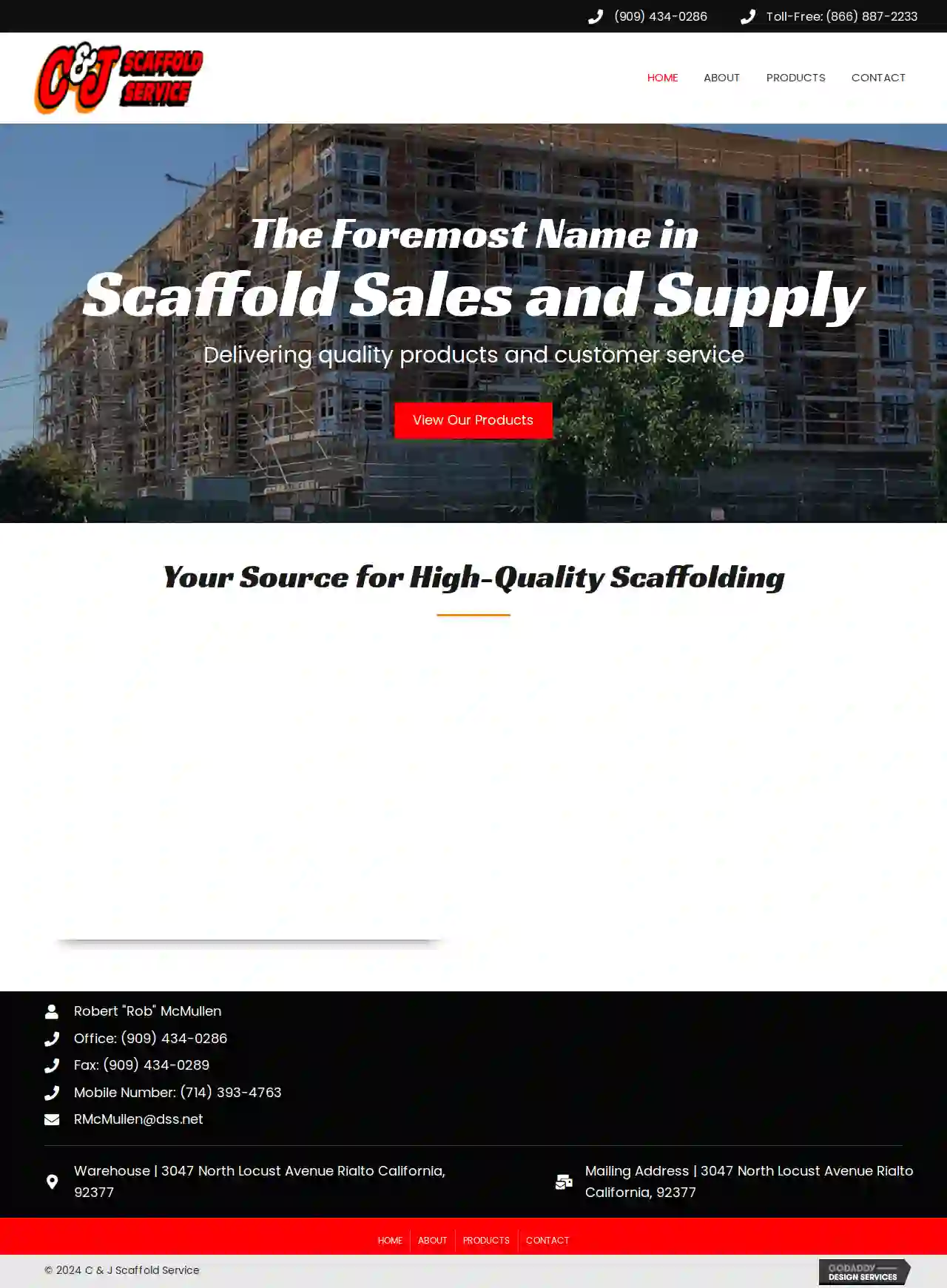
DIRECT SCAFFOLD SUPPLY
4.811 reviews3047 North Locust Avenue, Rialto, 92377, USWelcome to C & J Scaffold Service, the foremost name in scaffold sales and supply of all scaffolding-related products. With over 50 years of combined sales and technical experience in the scaffolding industry, we strive to provide you with the best in commercial-grade products, competitive pricing, and unmatched service and reliability. Our goal is to make sure your scaffolding needs are met and you are able to complete your project safely and with the best of equipment. We offer a full line of scaffolding and accessories, including scaffolding frames, cross braces, guard rail, guard posts, safety gates, base plates, screw jacks, folding trestles, extensions, tuffy jacks, flat backs, rolling scaffold units, aluminum hook plank, hatch decks, laminated and southern yellow pine plank, MFS scaffolding products, pins, casters, wheels, pulleys, manufacturing parts, locking devices, side brackets, safety signage and stickers, veneer frames, steel tubing, stairways, ladders and brackets, post shores, debris and safety tarps/netting, trash chutes, and systems scaffolding products to include ring lock, cup lock, and tube lock styles.
- Services
- Why Us?
- Accreditations
- Our Team
- Gallery
Get Quote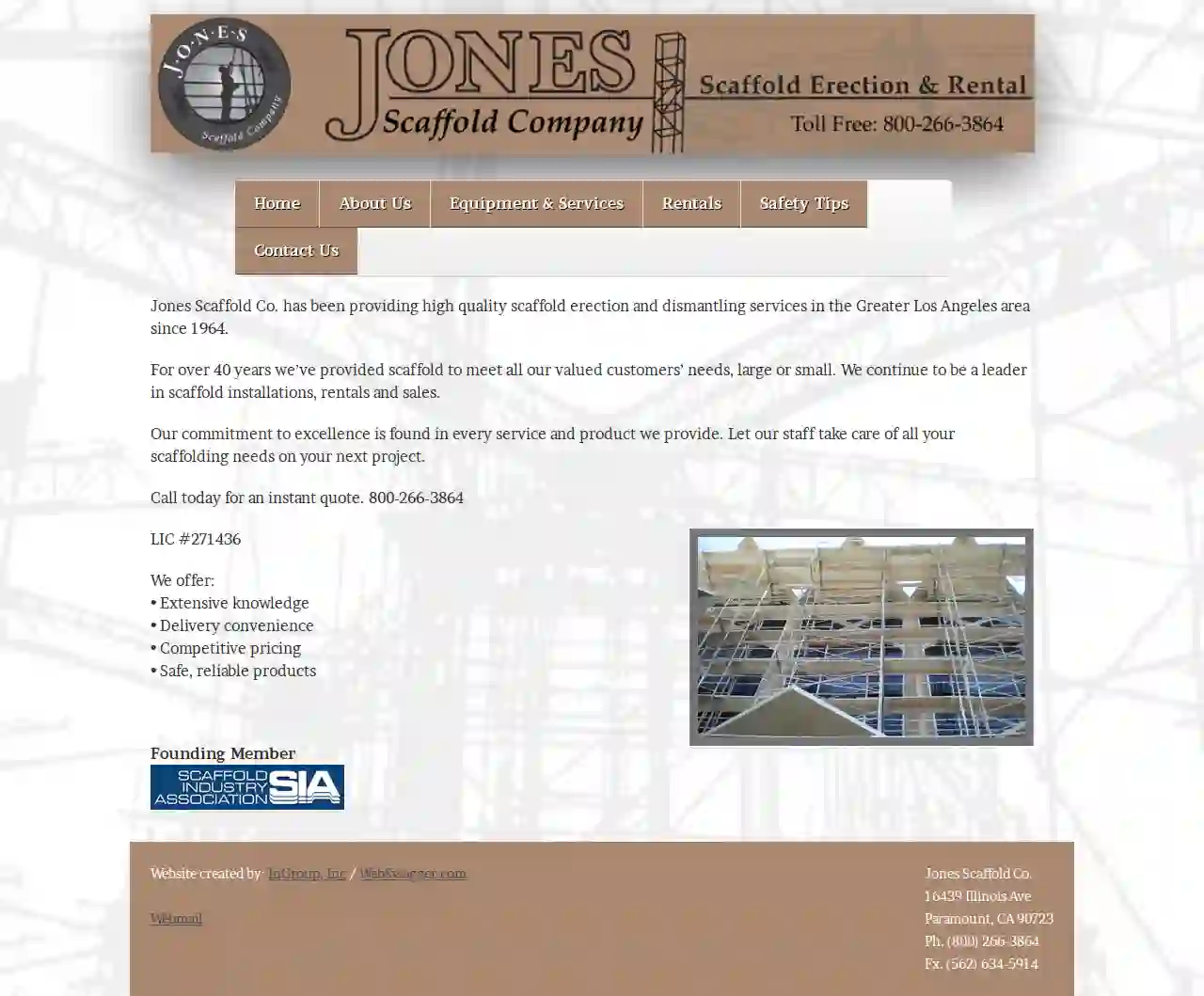
Jones Scaffold Co
3.25 reviews16439 Illinois Ave, Paramount, 90723, USJones Scaffold Co. has been providing high quality scaffold erection and dismantling services in the Greater Los Angeles area since 1964. For over 40 years we’ve provided scaffold to meet all our valued customers’ needs, large or small. We continue to be a leader in scaffold installations, rentals and sales. Our commitment to excellence is found in every service and product we provide. Let our staff take care of all your scaffolding needs on your next project. Call today for an instant quote. 800-266-3864 LIC #271436 We offer: Extensive knowledge Delivery convenience Competitive pricing Safe, reliable products Founding Member
- Services
- Why Us?
- Gallery
Get Quote
Ready Equipment Rental Inc.
421 reviews3969 N Sierra Way, San Bernardino, 92405, USAt Ready Equipment Rental, we have been providing our customers in the greater San Bernardino - Riverside Counties with an extensive variety of quality equipment rentals and tool rentals since 1988. From floor sanders to tile saws, utility trailers to tillers, tractors and bobcats to pressure washer's, we have the rental equipment and tools you need to build, maintain, power, move, or clean your projects. We are family owned, conveniently located at 3969 N Sierra Way, in San Bernardino Just north of the 210 Freeway and Waterman ave. We are here to help anyway we can for all your equipment rental and tool rental needs. Ask us about our affordable delivery and pickup, new and used equipment for sale.
- Services
- Why Us?
- Gallery
Get Quote
Major Scaffold, Inc.
55 reviews2908 E Hullett St, Long Beach, 90805, USMajor Scaffold, Inc. is a leading provider of scaffolding solutions in Southern California. With over 25 years of professional experience, the company is dedicated to providing quality services and building valued working relationships with its customers. Their commitment to safety, quality, and quick response service sets them apart from competitors. They offer a wide range of scaffolding solutions including frame scaffolds, pin lock systems, shoring, platforms, stair towers, rolling scaffolds, pedestrian canopies, netting containment, shrinkwrap containment, and trash chutes. Their team is experienced and dedicated to solving everyday scaffolding needs efficiently and effectively.
- Services
- Why Us?
- Accreditations
- Our Team
- Testimonials
- Gallery
Get Quote
Skyway USA
51 reviewsVallejo, USSkyway: Your Trusted Partner for Industrial and Commercial Solutions Skyway is a leading provider of industrial and commercial scaffolding, shoring, and safety systems. We have been serving the Canadian market for over 49 years, and we are committed to providing our clients with the highest quality products and services. Our Mission Our mission is to provide our clients with safe, efficient, and cost-effective solutions that meet their specific needs. We are dedicated to providing our clients with the highest level of customer service and support. Our Values Our values are safety, quality, innovation, and customer service. We are committed to providing our clients with the highest level of safety and quality. We are constantly innovating to develop new and improved products and services. And we are dedicated to providing our clients with the best possible customer service. Our Services We offer a wide range of services, including: Industrial Scaffolding Insulation Painting and Protective Coating Fireproofing Abatement Access Scaffolding Swing Stage Shoring Forming Fencing Hoardings Debris Chutes 3D Digital Services Why Choose Skyway? There are many reasons to choose Skyway for your next project. We are: Experienced: We have over 49 years of experience in the industry. Reliable: We are committed to providing our clients with the highest level of quality and service. Innovative: We are constantly developing new and improved products and services. Customer-focused: We are dedicated to providing our clients with the best possible customer service.
- Services
- Why Us?
- Gallery
Get Quote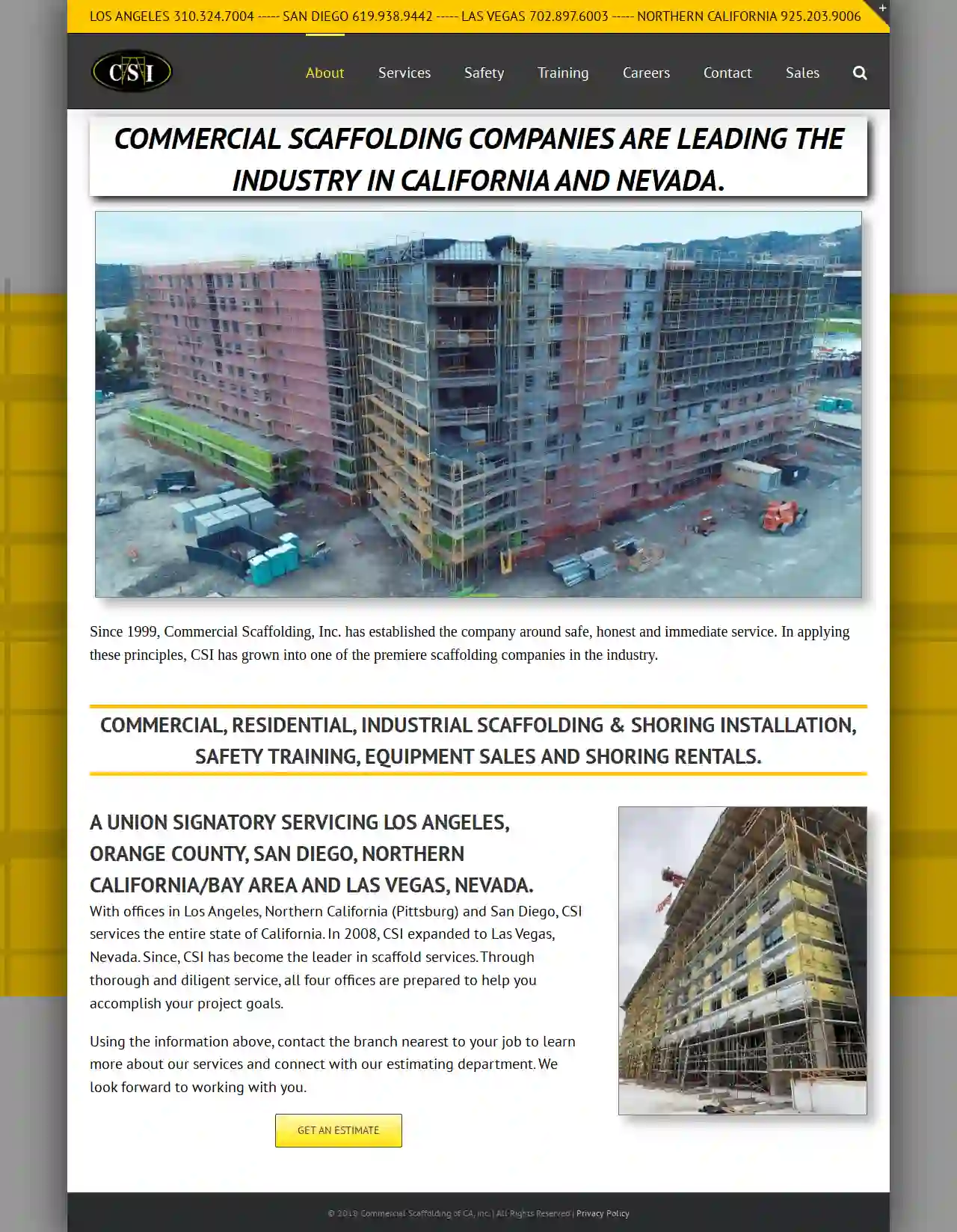
Commercial Scaffolding of CA, Inc.
4.54 reviewsLos Angeles, USAbout Commercial Scaffolding, Inc. Since 1999, Commercial Scaffolding, Inc. (CSI) has been a leading provider of scaffolding services in California and Nevada. We are committed to providing safe, honest, and immediate service to our clients. This commitment has allowed us to grow into one of the premier scaffolding companies in the industry. We offer a wide range of scaffolding and shoring services, including: Commercial scaffolding Residential scaffolding Industrial scaffolding Shoring installation Safety training Equipment sales Shoring rentals We are a union signatory and serve the following areas: Los Angeles Orange County San Diego Northern California/Bay Area Las Vegas, Nevada With offices in Los Angeles, Northern California (Pittsburg), and San Diego, CSI services the entire state of California. In 2008, CSI expanded to Las Vegas, Nevada. Since then, CSI has become the leader in scaffold services. Through thorough and diligent service, all four offices are prepared to help you accomplish your project goals. Contact the branch nearest to your job to learn more about our services and connect with our estimating department. We look forward to working with you.
- Services
- Why Us?
- Our Team
- Gallery
Get Quote
D L Scaffolding Inc
54 reviewsSan Rafael, USAt DL Scaffolding Inc, we provide safe, high-quality, and timely scaffold services to our clients in the San Francisco Bay Area and beyond. With a strong focus on trust, integrity, dependability, efficiency, detail-orientedness, and timeliness, we strive to deliver exceptional results that meet our clients' specific project needs. Our team of experts offers a range of services, including scaffold design and planning, scaffold erection, scaffold dismantling, scaffold rental, deliver and pick-up, and project management. We take pride in our ability to provide end-to-end scaffold services that ensure on-time completion and adherence to safety standards.
- Services
- Why Us?
- Gallery
Get Quote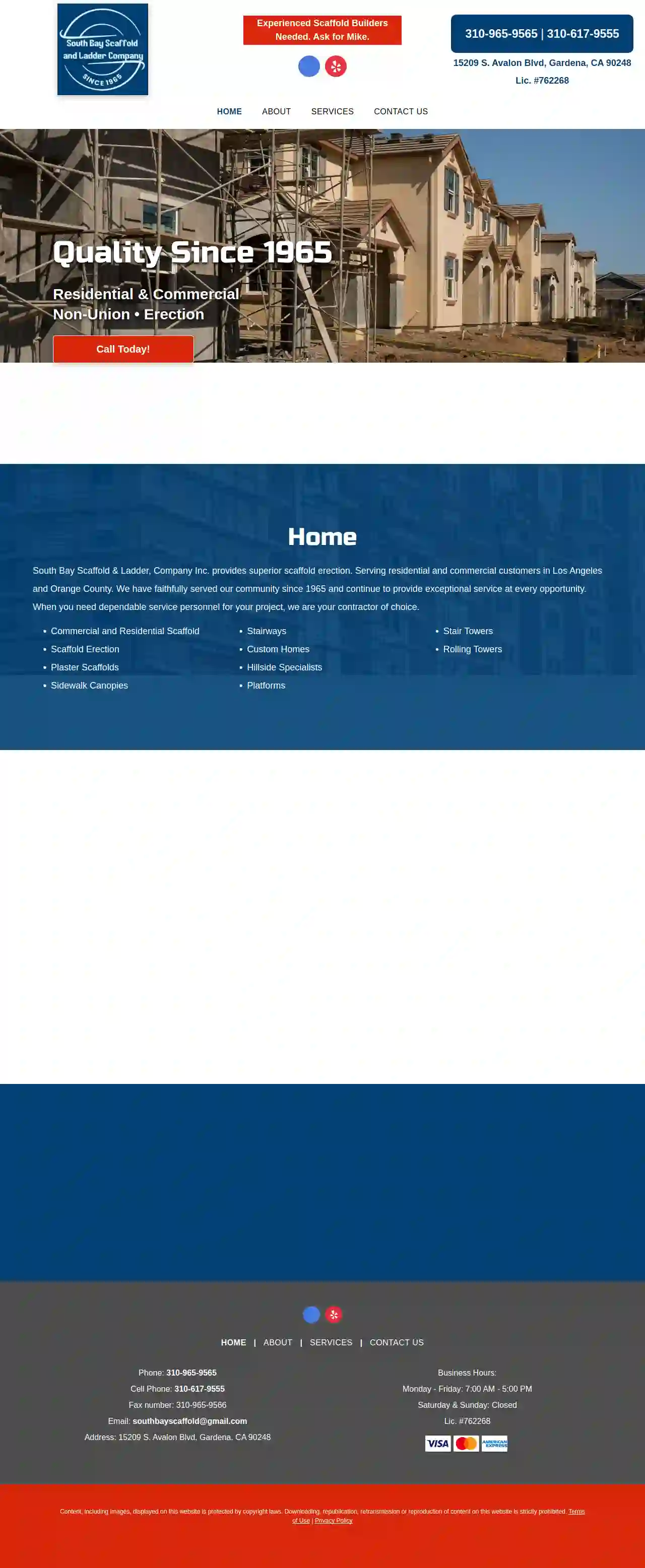
South Bay Scaffold & Ladder
3.54 reviews15209 S. Avalon Blvd, Gardena, 90248, USAt South Bay Scaffold & Ladder, Company Inc., we've been providing superior scaffold erection services to residential and commercial customers in Los Angeles and Orange County since 1965. Our team of experts is dedicated to delivering exceptional service at every opportunity. Whether you need dependable service personnel for your project, we're your contractor of choice. Our services include commercial and residential scaffold erection, plaster scaffolds, sidewalk canopies, stairways, custom homes, hillside specialists, platforms, and stair towers. Rolling towers are also available. We're conveniently located at 15209 S. Avalon Blvd in Gardena, just five blocks East of the 110 Freeway. Call us today at 310-965-9565 to discuss your scaffolding needs.
- Services
- Why Us?
- Accreditations
- Our Team
- Gallery
Get Quote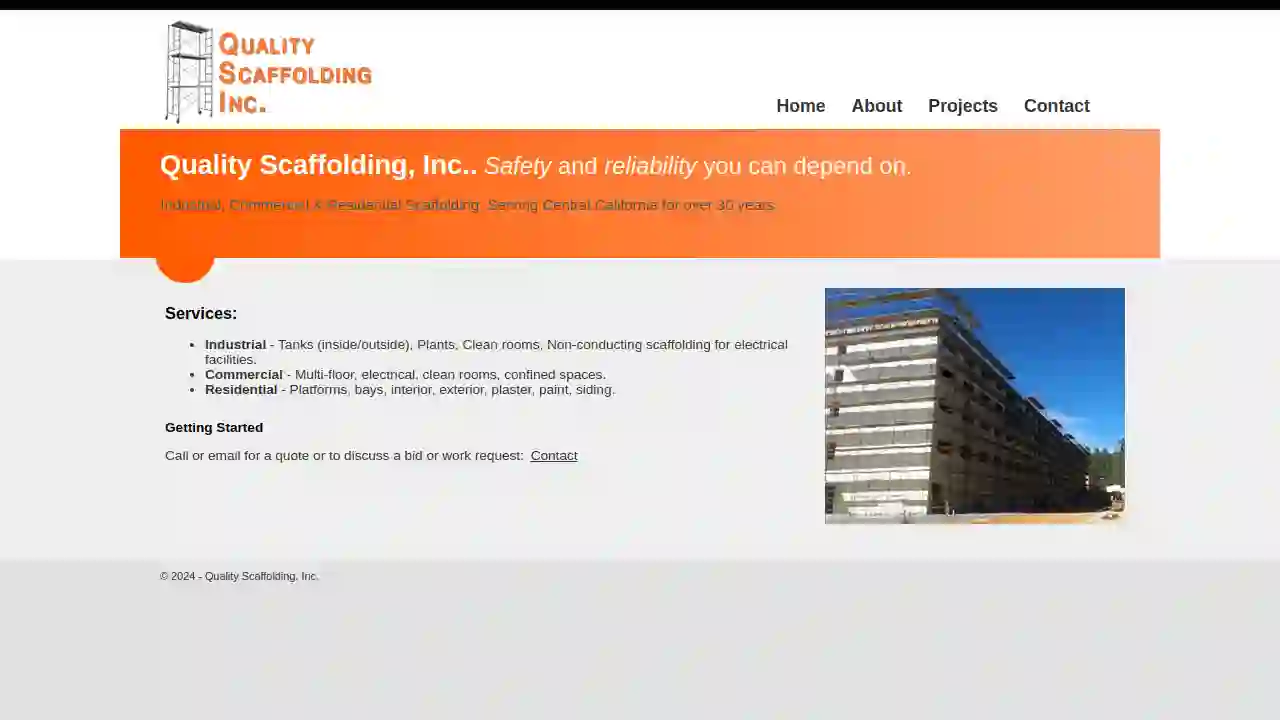
Quality Scaffolding, Inc.
4.25 reviews123 Scaffolding Lane, Scaffolding City, SC, 12345, USQuality Scaffolding, Inc. is a leading provider of scaffolding solutions, offering safety and reliability that you can depend on. With over 30 years of experience serving Central California, they specialize in industrial, commercial, and residential scaffolding. Their services include tanks, plants, clean rooms, non-conducting scaffolding for electrical facilities, multi-floor, electrical, clean rooms, confined spaces, platforms, bays, interior, exterior, plaster, and paint, and siding. To get started, customers can call or email for a quote or to discuss a bid or work request.
- Services
- Why Us?
- Accreditations
- Our Team
- Testimonials
- Gallery
Get Quote
Over 2,353+ Scaffolding Companies in our network
Our scaffolding experts operate in Canyon Lake and surrounding areas!
ScaffoldingHQ has curated and vetted Top Scaffolding Businesses near Canyon Lake. Find a reliable contractor today.
Frequently Asked Questions About Scaffolding Rental
- Stop Using It Immediately: Do not attempt to use damaged scaffolding. It could be unsafe.
- Contact the Rental Company: Notify the scaffolding rental company about the damage as soon as possible.
- Document the Damage: Take photos or videos of the damage for documentation. The rental agreement should outline the procedures for handling damaged equipment. You may be responsible for repair or replacement costs, depending on the circumstances and the terms of the agreement.
- All Components: Ensure all the necessary components (tubes, clamps, boards, braces, etc.) are present and in good condition.
- Damage or Defects: Look for any signs of damage, rust, or defects on the scaffolding parts.
- Scaffolding Tag: Verify that the scaffolding tag is up-to-date and shows the last inspection date.
- Safety Features: Check that guardrails, toeboards, and other safety features are included and in working order.
- Has a single working platform, typically about 60-70cm wide.
- Suitable for tasks where limited space is available.
- Has a wider working platform, usually about 1.3-1.4 meters wide.
- Provides more working space and stability, allowing for movement of materials and multiple workers.
- Working Height: Measure the height of the area you need to access, adding a safety margin for guardrails.
- Project Scope: Consider the tasks you'll be performing on the scaffolding and the space required for workers, materials, and equipment.
- Site Access and Constraints: Evaluate the available space for erecting the scaffolding and any obstacles (trees, structures, utilities) that might restrict size.
What happens if the scaffolding is damaged during my rental period?
What should I check for when the scaffolding is delivered?
What is the difference between single and double scaffolding?
Single Scaffolding:
How do I know what size scaffolding I need?
What happens if the scaffolding is damaged during my rental period?
- Stop Using It Immediately: Do not attempt to use damaged scaffolding. It could be unsafe.
- Contact the Rental Company: Notify the scaffolding rental company about the damage as soon as possible.
- Document the Damage: Take photos or videos of the damage for documentation. The rental agreement should outline the procedures for handling damaged equipment. You may be responsible for repair or replacement costs, depending on the circumstances and the terms of the agreement.
What should I check for when the scaffolding is delivered?
- All Components: Ensure all the necessary components (tubes, clamps, boards, braces, etc.) are present and in good condition.
- Damage or Defects: Look for any signs of damage, rust, or defects on the scaffolding parts.
- Scaffolding Tag: Verify that the scaffolding tag is up-to-date and shows the last inspection date.
- Safety Features: Check that guardrails, toeboards, and other safety features are included and in working order.
What is the difference between single and double scaffolding?
Single Scaffolding:
- Has a single working platform, typically about 60-70cm wide.
- Suitable for tasks where limited space is available.
- Has a wider working platform, usually about 1.3-1.4 meters wide.
- Provides more working space and stability, allowing for movement of materials and multiple workers.
How do I know what size scaffolding I need?
- Working Height: Measure the height of the area you need to access, adding a safety margin for guardrails.
- Project Scope: Consider the tasks you'll be performing on the scaffolding and the space required for workers, materials, and equipment.
- Site Access and Constraints: Evaluate the available space for erecting the scaffolding and any obstacles (trees, structures, utilities) that might restrict size.